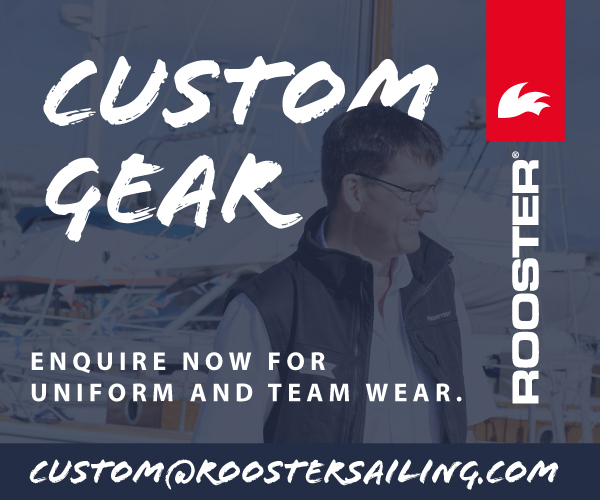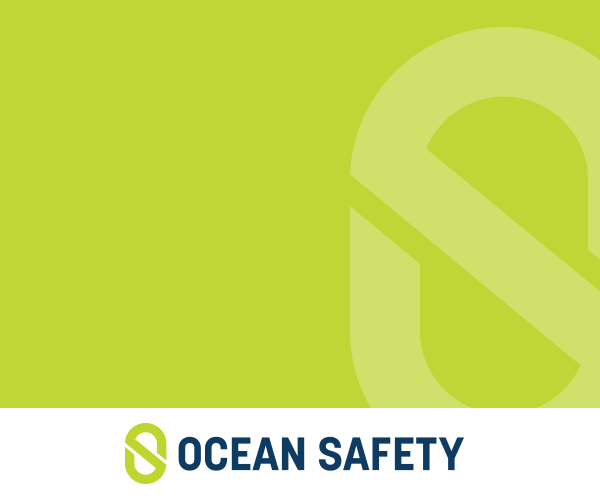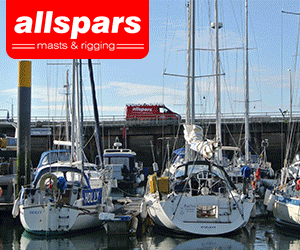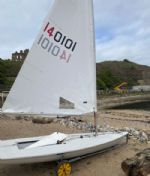










-(1)-202408140552.gif)

Boats for sale
| Rossiter Pintail Mortagne sur Gironde, near Bordeaux |
 |
| Laser 28 - Excellent example of this great design Hamble le rice |
 |
| Laser 140101 Tynemouth |
 |
List classes of boat for sale |
Rescue mandated to attend capsize? |
Post Reply 
|
Page 123 5> |
| Author | |
JimC 
Really should get out more 

Joined: 17 May 04 Location: United Kingdom Online Status: Offline Posts: 6662 |
 Post Options Post Options
 Quote Quote  Reply Reply
 Topic: Rescue mandated to attend capsize? Topic: Rescue mandated to attend capsize?Posted: 23 Oct 14 at 10:02am |
|
The reason I rate the rig to windward method so much is that its reliable and repeatable for all levels of expertise and daring. The rig may have been to leeward when the Comet Trio capsized, but will it still be to leeward by the time everyone has got their breath back, sorted themselves out and got in position?
Surely you've seen people getting into capsize after capsize because by the time they are ready the hull has drifted downwind again? If that's happened they are stuck with either trying to bring the boat up very slowly and hoping a backed jib will blow the rig back downwind, or else trying the roll bit, which I would not be happy with recommending to people who weren't experienced. With the rig to windward method it seems to work first time every time, and it may not even be necessary for the crew to climb on the board: if they can just lift the mast out of the water by tugging on the board from in the water the wind will do the rest. I very strongly recommend everyone tries it. |
|
 |
|
Rupert 
Really should get out more 
Joined: 11 Aug 04 Location: Whitefriars sc Online Status: Offline Posts: 8956 |
 Post Options Post Options
 Quote Quote  Reply Reply
 Posted: 23 Oct 14 at 8:12am Posted: 23 Oct 14 at 8:12am |
|
Surely each method has its uses because of the many different ways it is possible to tip a boat in?
If I go splat to leeward in a Comet Trio, then the RYA method is ideal. Huge splat down wind to windward in a Cherub, not so much. |
|
|
Firefly 2324, Puffin 229, Minisail 3446 Mirror 70686
|
|
 |
|
JimC 
Really should get out more 

Joined: 17 May 04 Location: United Kingdom Online Status: Offline Posts: 6662 |
 Post Options Post Options
 Quote Quote  Reply Reply
 Posted: 23 Oct 14 at 7:59am Posted: 23 Oct 14 at 7:59am |
|
I'm with Chris on this. The scoop method with the rig to leeward is not IME reliable in big breeze for modern boats. The roll thing is the least worst option for singlehanders, but it's pointless at best for two handers because the Aus navy method works so well.
|
|
 |
|
Chris 249 
Really should get out more 

Joined: 10 May 04 Online Status: Offline Posts: 2041 |
 Post Options Post Options
 Quote Quote  Reply Reply
 Posted: 23 Oct 14 at 2:29am Posted: 23 Oct 14 at 2:29am |
|
I know it's the windward jibsheet that's used, but while the hull will block the wind from the jib while the boat is well heeled early in the recovery, what happens when the boat comes more upright?
I can recall several incidents when the boat wouldn't come up at all because a jib was sheeted on, and if the wind is strong enough to capsize a dinghy hove to in the classical sense will often get blown over.
Edited by Chris 249 - 23 Oct 14 at 2:30am |
|
 |
|
zippyRN 
Far too distracted from work 
Joined: 14 Sep 06 Online Status: Offline Posts: 437 |
 Post Options Post Options
 Quote Quote  Reply Reply
 Posted: 23 Oct 14 at 12:53am Posted: 23 Oct 14 at 12:53am |
sounds like someone has been teaching it wrong then it'sthe windward jib sheet that is used to right the boat backwinding the jib
as the rudder will generally want to turn the boat to windward and the classic position relative to the wind for the unassisted recovery of a leeward capsize ends up with the boat on a beam reach ... the recovered boat should then right itslef and sit hove to ... |
|
 |
|
davidyacht 
Really should get out more 
Joined: 29 Mar 05 Online Status: Offline Posts: 1345 |
 Post Options Post Options
 Quote Quote  Reply Reply
 Posted: 22 Oct 14 at 10:37pm Posted: 22 Oct 14 at 10:37pm |
|
Yes if you are lucky you may catch the boat before she goes over again, all in all a useful tool.
|
|
 |
|
Chris 249 
Really should get out more 

Joined: 10 May 04 Online Status: Offline Posts: 2041 |
 Post Options Post Options
 Quote Quote  Reply Reply
 Posted: 22 Oct 14 at 10:16pm Posted: 22 Oct 14 at 10:16pm |
|
The capsize recovery method I really cannot understand is the one where the crew gets inside the boat and throws the jibsheet over to the helm, who then pulls on it while they lean back.
Maybe it's just the boats I sail, but if the wind is strong enough for you to capsize then you're unlikely to be able to right the boat with the jib sheeted in, and secondly if the jib is sheeted in then the bow will blow away to leeward and everything can go pear-shaped. BTW I thought the idea of the SF roll was that the boat DOESN'T capsize a second time, because the sailor holds onto the centreboard and effectively becomes ballast while they reach around and grab the windward gunwale and/or the drag of their body swings the rig around. The other great trick to come from San Francisco is the Bennett's Bath, which is quite fun! But it's a way to turn the dreaded high-speed downwind roll to windward into a high-speed dunking and therefore a capsize prevention technique. While I'm rambling - back in the 1800s, some leading authorities campaigned to DSQ boats that capsized because once one boat went in, the law of the sea meant that all racing boats nearby had to stand by them as they were a vessel in distress. This distorted the race if the boat that capsized was something like a Rater or Canoe that could be righted almost immediately and with no problems. For example, someone (maybe Morgan Giles) wrote about an incident in which Linton Hope capsized his Rater on the Solent. Giles headed his own Rater back to help as he felt he had to do (there were of course no outboard powered rescue boats at that time) only to see Hope just hop onto the centreboard, right the boat with no water aboard, and sail away, having (IIRC) increased his lead because Giles was trying to help him. It was an interesting vignette to me because it underlined once again that ancient rules and attitudes that seem nonsensical were often highly logical and practical at the time they were created. One thing that hasn't changed is that AFAIK crews still often check that everything is OK when a boat capsizes in a race, which is nice to know.
Edited by Chris 249 - 22 Oct 14 at 10:19pm |
|
 |
|
JimC 
Really should get out more 

Joined: 17 May 04 Location: United Kingdom Online Status: Offline Posts: 6662 |
 Post Options Post Options
 Quote Quote  Reply Reply
 Posted: 22 Oct 14 at 3:14pm Posted: 22 Oct 14 at 3:14pm |
|
Australian Navy method.
You need the rig to windward, which is rarely a problem! Crew stay together, and can both bring the boat up from inverted if necessary. Then one (A) gets on the board, the other (B) goes to the bow. As the sailor on the board gets ready to lift the mast B ducks under the jib and goes to the shroud (the under water side one). As the boat comes up they wrap *both* arms round the shroud and just hang on, making no attempt to get in the boat at all. Instead B stays hanging on the shroud, and with that much weight so well and securely placed the boat will not flip over. With B holding on the shroud their body drag acts as a sea anchor and the boat, which would have been cross wind when started, will sit steadily hove to. A may have rolled into the boat as it came up, but on boats with low and long booms are probably better advised to drop into the water to avoid the boom. If in the water they go to the stern, and climb in, the boat will stay hove to with the sailor on the shroud. With the boat hove to A sorts out rudder, ropes etc, and then finally helps B into the boat, which is readily done with the boat hove to. Not the quickest method, but the only time I've known it not work first time is when the sailors were so light that the one on the board couldn't lift the mast enough for the wind to catch it. Edited by JimC - 22 Oct 14 at 3:20pm |
|
 |
|
davidyacht 
Really should get out more 
Joined: 29 Mar 05 Online Status: Offline Posts: 1345 |
 Post Options Post Options
 Quote Quote  Reply Reply
 Posted: 22 Oct 14 at 2:58pm Posted: 22 Oct 14 at 2:58pm |
|
Ref. San Fransciso Roll, this is a really useful tool if the rig is pointing upwind, and you know the boat is going to come on top of you, particularly in singlehanders, but also used it in 14's. In these situations you would probably be doing a sequence of capsizes, if you go straight to the SF roll, yes you have to capsizes, but if you do it right, the first one is power assisted as the wind does the work, and the second is easy, because you should be on top of the board and to windward of the boat.
This works really well in Solo's, because 1. in a normal situation it is a high climb up onto the board, and 2. also when you do the roll, the boat will eventually come up pretty dry, 3. there is less chance of getting separated from the boat when you have to swim around the boat!
|
|
 |
|
zippyRN 
Far too distracted from work 
Joined: 14 Sep 06 Online Status: Offline Posts: 437 |
 Post Options Post Options
 Quote Quote  Reply Reply
 Posted: 22 Oct 14 at 2:33pm Posted: 22 Oct 14 at 2:33pm |
|
San franscisco roll = turning a windward capsize into a leeward capsize by righting the boat and being swpet under the hull as the boat rights,and then capsizes again to leeward - you still need to have the strength and reserve to do 2 capsize recoveries and get back aboard
Jim care to descrbe the rig to windward approach, if it;s what i think it many i think i've done it in two man boats before - very much like the scoop method but the person who says in has to settle and stabilsed the boat before recovering their crewmate who is to leeward initially over the stern. |
|
 |
|
Post Reply 
|
Page 123 5> |
| Forum Jump | Forum Permissions  You cannot post new topics in this forum You cannot reply to topics in this forum You cannot delete your posts in this forum You cannot edit your posts in this forum You cannot create polls in this forum You cannot vote in polls in this forum |
Bulletin Board Software by Web Wiz Forums® version 9.665y
Copyright ©2001-2010 Web Wiz
Change your personal settings, or read our privacy policy
Copyright ©2001-2010 Web Wiz
Change your personal settings, or read our privacy policy












 Printable Version
Printable Version Delicious
Delicious Digg
Digg Facebook
Facebook Furl
Furl Google
Google MySpace
MySpace Newsvine
Newsvine reddit
reddit StumbleUpon
StumbleUpon Twitter
Twitter Windows Live
Windows Live Yahoo Bookmarks
Yahoo Bookmarks Topic Options
Topic Options